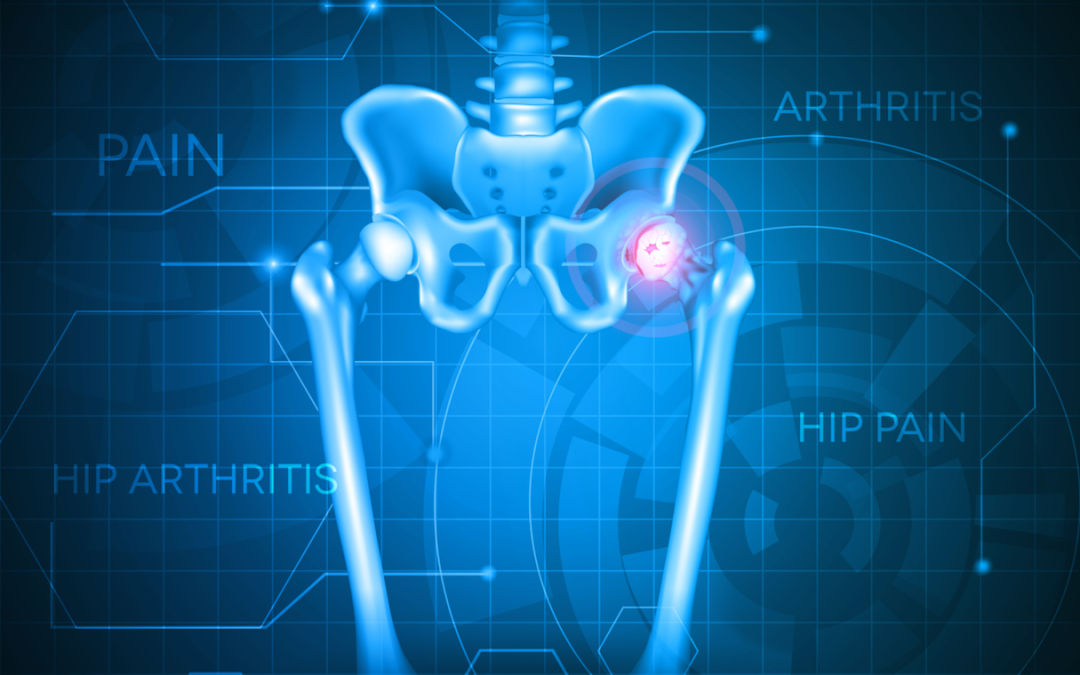Recently, it was reported that 22% of the U.S. population suffers from some form of arthritis. That percentage increases in the elderly to over 50%, with 1 in 4 suffering from hip arthritis before the age of 85. The term “arthritis” refers to one of numerous forms of degeneration and/or inflammation of the hip joint, which can result in pain localized to the hip and groin region. This is a progressive condition that typically worsens over time. There are numerous types of arthritis that can affect the hip, however three of these types account for the most common causes of degeneration and pain in the hip.
Hip Anatomy
The hip is one of the body’s largest weight-bearing joints and it is the area where thighbone connects to the pelvis. This is a ball-in-socket type of joint that is connected by bands of tissues called ligaments. There are two parts of the hip joint: the femoral head (located at the top of the thighbone), and the acetabulum (the pelvic socket that houses the femoral head). The ligaments that connect these points surround the joint capsule. The capsule is lined with synovium, a thin protective membrane that produces a viscous fluid, which lubricates the joint. Fluid-filled sacs called bursae are found over the areas where bones, tendons, and muscles meet glide over the bone and may cause friction. Multiple large muscles surround the hip and support movement and flexibility.
Types of Arthritis
There are numerous types of arthritis affecting the joints of the hip, which result in degeneration and/or inflammation, which may result in stiffness and loss of mobility.
Osteoarthritis: This is the most common form of arthritis found in the hip. It means “arthritis of the bone.” Osteoarthritis is far more common in the elderly and referred to as “wear and tear” on the joints. When the smooth cartilage in the joint wears away, the exposed bones, which contain nerve endings, may rub together and cause pain. This form of arthritis typically leads to degeneration and permanently damages the joint.
Rheumatoid Arthritis: This auto-immune disorder affects the entire body, rather than just the hip joint and is caused by an auto-immune response in which the synovial lining that surrounds the joint capsule becomes swollen and inflamed, and secretes enzymes which degrade and break down the cartilage, exposing the bone, which results in pain and, eventually, deterioration of the bone and joint.
Psoriatic Arthritis: This less common form of arthritis is often related to the skin disease, psoriasis. It can cause stiffness, swelling, and pain in any joint. Generally, patients will have the skin disease first, characterized by scaly red patches on the skin; however, it is possible to develop the arthritis form of the condition first.
Symptoms of Arthritis of the Hip
All types of arthritis of the hip share the same symptoms, which may include the following:
- Pain in and around the hip, primarily involving the thigh and groin regions, and occasionally the buttock regions
- Difficulty walking
- Pain with prolonged or vigorous activity
- Stiffness or limited range of motion
- Pain that is worse in the morning, or after a period of inactivity but that lessens after light activity or stretching
Dr. Nicholas Alexander is the Founder of Mahwah Valley Orthopedic Associates and a Board Certified Orthopedic Surgeon specializing in both the surgical and non-surgical treatment of hip and knee conditions. Dr. Alexander completed his Fellowship in Adult Reconstruction and Reconstructive Surgery of the Hip and Knee at the Johns Hopkins School of Medicine and has over two decades of experience. He also serves as the Chairman of the Valley Hospital Total Joint Center. Dr. Alexander has offices in Mahwah and Clifton, NJ. If you, or someone you love, is considering treatment for a hip or knee injury, contact us today for a consultation.

